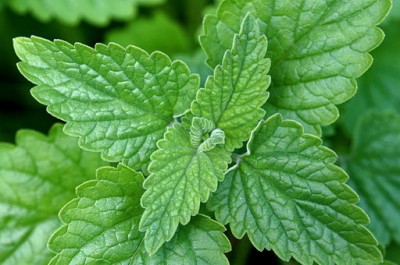Catnip is perhaps best known for its ability to give cats a “high”; however, it has many other uses as well. For many years herbalists have used the leaves to treat fevers, pain, anxiety, and even intestinal parasites. It can also be used as a natural pest repellent.
Background: Catnip is a perennial member of the mint family. It is thought to have originated in Europe and was imported to America. It is easily grown and is not fussy about soil conditions or watering. Catnip has erect, square, branched stems and heart-shaped, saw-toothed leaves that are covered with fine downy hairs, mostly on the underside, which lend to its grayish hue. Small, tubular, two-lipped blooms appear from June to September. They grow densely in whorls atop the stems and come in shades from white to lavender with reddish to purple spots. The whole plant has a mild, minty perfume.
Other Natural Remedies for The Entire Family…
Names: Catnip (or Nepeta cataria): “Nepeta” is thought to have come from the town of Nepete, Italy, and Cataria may be from the Latin word for cat.
Catnip has many common names—among them are: Cataria, Catmint, Catnep, Catrup, Cat’s Heal All, Cat’s-play, Cat’s Wort, Catswort, Catwort, Chi Hsueh Tsao, Field Balm, Garden Nep, Herba Cataria, Herba Catti, Nebada, and Nep. The active ingredient is an essential oil called nepetalactone, which is found in the leaves and stems of the plant.
Varieties:
Common Catnip (Nepeta cataria): Grows to three feet tall and has white blossoms. This is a cat’s favorite variety.
Camphor Catnip (Neptha camphorate): Grows to ten inches tall and has white flowers with purple dots. It also has a camphor-like scent.
Greek Catnip (Nepeta parnassica): Grows eighteen inches tall and has white or pale pink flowers.
Lemon Catnip (Nepeta cataria citriodora): Grows up to three feet tall and has white flowers with purple spots. Its leaves have a lemony scent.
Catmint (Nepeta mussinii): Grows to fifteen inches tall with smallish, grey/green leaves and purple flowers.
Medicinal Properties: Pain reliever, antispasmodic, relieves gas and bloating, aromatic, produces perspiration, soothing to the nerves, and slightly calmative, antibiotic, astringent, diuretic, muscle aches, toothache, hemorrhoid relief and cold in the joints.
K’Eogh wrote in his treatise, Irish Herbal, “It provokes urination and menstruation: it expels the stillborn child; it opens obstructions of the lungs and the womb, and is good for internal bruises and shortness of breath. Drunk with salt and honey, it expels worms from the body.”
Uses: One of the oldest household remedies, catnip is safe enough for children as well as adults. An infusion made of one tablespoon of leaves steeped in a pint of boiling water used as an enema can be effective in relieving fevers, convulsions, and for removing worms from the intestines of children. This infusion is also very useful for treating pain of any kind, spasms, gas pain and hyperacidity in the stomach. A high enema of catnip infusion can relieve headaches and restore good menstruation. A warm enema of catnip will return the free flow of urine when it has been blocked.
In cases of hysteria or anxiety, one should make a tea of one tablespoon of catnip to a pint of boiling water, let steep thirty minutes, and then drink hot or warm. A cupful may be taken four to five times daily as long as necessary.
Equal parts of catnip, sweet balm, marshmallow and sweet weed make an excellent remedy for babies and small children. A little honey, malt honey, or maple syrup may be added to make it more palatable.
Catnip has been used to treat scarlet fever, coughing, insomnia, and small pox. A crushed leaf can be used to treat cuts and bruises, just dampen and apply to the affected area.
Rubbing catnip leaves over the skin works better to repel mosquitoes than the chemical DEET, as it is ten times stronger. Catnip has also been found to repel cockroaches, ants, and some other insects too. It has also been found that rats and mice strongly dislike catnip and will avoid places where it is grown.
Catnip should always be steeped—never boiled. It may be freely taken internally and externally! It can also be added to salads and cooking as an aromatic herb.
Growing Catnip: It grows very easily; it likes a light, sandy soil and grows best in full sun. Above-ground parts of the plant should be harvested shortly after blooming.
To Dry: Bundle loosely and hang upside down in a well-ventilated area, away from the sun.
Folklore: It was once believed that if one smoked the leaves it would produce mild hallucinations. Although this has use has been overcome in large part, the herb may produce this effect in a few individuals. It is also believed to calm children given to fits and nightmares.
According to The Herb Garden, “The root when chewed is said to make the most gentle person fierce and quarrelsome.” In fact, there is a story about an executioner who would have to chew on the root of catnip so he could bring himself to kill.
Another Side Note: Valerian and all plants containing actinidine will produce the same effect in felines as catnip.
Warning: Catnip should not be ingested by pregnant women. As with any herbal remedy, you should always check with your healthcare provider before taking catnip for any medicinal purposes.
Resources:
Back to Eden by Jethro Kloss, ©1939 Back to Eden Publishing Co.
https://www.gardensablaze.com/HerbCatnipMed.htm
https://www.cat-world.com.au/all-about-catnip
https://www.altnature.com/gallery/catnip.htm
©2012 Off the Grid News
 Off The Grid News Better Ideas For Off The Grid Living
Off The Grid News Better Ideas For Off The Grid Living





